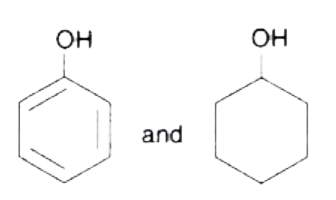Give one chemical test to distinguish between the following pairs of compounds :
Acetone and benzaldehyde.
To distinguish between acetone and benzaldehyde, we can use Tollens' reagent, which is a solution of ammoniacal silver nitrate. Here are the steps to perform the test:
Step 1: Prepare Tollens' Reagent
- Mix silver nitrate (AgNO3) with ammonium hydroxide (NH4OH) to form Tollens' reagent. This reagent will appear as a clear solution.
Step 2: Add the Compound
- Take two separate test tubes. In one test tube, add a few drops of acetone (CH3COCH3), and in the other test tube, add a few drops of benzaldehyde (C6H5CHO).
Step 3: Add Tollens' Reagent
- To both test tubes, add a few drops of Tollens' reagent.
Step 4: Warm the Mixture
- Gently warm both test tubes in a water bath for a few minutes.
Step 5: Observe the Results
- Observe the test tubes for any changes.
- In the test tube with benzaldehyde, you should see a silver mirror forming on the walls of the container.
- In the test tube with acetone, there will be no silver mirror formation.
Conclusion
- The formation of a silver mirror indicates the presence of an aldehyde (benzaldehyde), while the absence of a silver mirror indicates the presence of a ketone (acetone).
Summary of the Reaction
- For benzaldehyde (RCHO):
- RCHO + Ag(NH3)2OH → RCOOH + Ag (silver mirror)
- For acetone (CH3COCH3):
- No reaction occurs.
- Mix silver nitrate (AgNO3) with ammonium hydroxide (NH4OH) to form Tollens' reagent. This reagent will appear as a clear solution.
- Take two separate test tubes. In one test tube, add a few drops of acetone (CH3COCH3), and in the other test tube, add a few drops of benzaldehyde (C6H5CHO).
- To both test tubes, add a few drops of Tollens' reagent.
- Gently warm both test tubes in a water bath for a few minutes.
- Observe the test tubes for any changes.
- In the test tube with benzaldehyde, you should see a silver mirror forming on the walls of the container.
- In the test tube with acetone, there will be no silver mirror formation.
- The formation of a silver mirror indicates the presence of an aldehyde (benzaldehyde), while the absence of a silver mirror indicates the presence of a ketone (acetone).
- For benzaldehyde (RCHO):
- RCHO + Ag(NH3)2OH → RCOOH + Ag (silver mirror)
- For acetone (CH3COCH3):
- No reaction occurs.
Topper's Solved these Questions
- BOOK - ICSECHAPTER - CHEMISTRY-2019EXERCISE - Question (Answer the following questions)5videos
CHEMISTRY-2019
- BOOK - ICSECHAPTER - CHEMISTRY-2018EXERCISE - Question (Answer the following question)5videos
CHEMISTRY-2018
- BOOK - ICSECHAPTER - CHEMISTRY-2020 EXERCISE - Question (Answer the following question)4videos
CHEMISTRY-2020
Similar Questions
Give a chemical test to distinguish between the following pairs of compounds:
 View Solution
View SolutionGive one chemical test to distinguish between the following pairs of compounds :
Acetaldehyde and benzaldehydeView SolutionGive chemical test to distinguish between
 View Solution
View SolutionGive any chemical test to distinguish between the following pair of compounds : acetine and phenol.
View SolutionGive one chemical test to distinguish between the following pairs of compounds :
Phenol and benzoic acid.View SolutionGive one chemical test to distinguish between the following pairs of compounds :
Ethanol and acetic acidView SolutionGive one good chemical test to distinguish between the following pairs of compounds :
Methanal and ethanal.View SolutionGive one chemical test to distinguish between the following pairs of compounds :
Ethanol and 2 propanol.View SolutionWrite chemical tests to distinguish between the following pairs of compounds :
Acetophenone and benzophenone.View SolutionGive one chemical test to distinguish between the following pairs of compounds :
Ethanol and dimethyl etherView Solution
